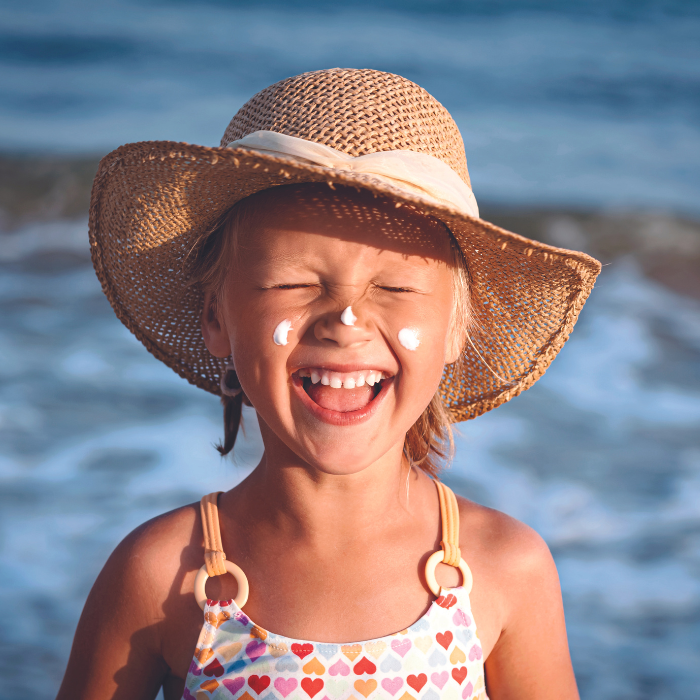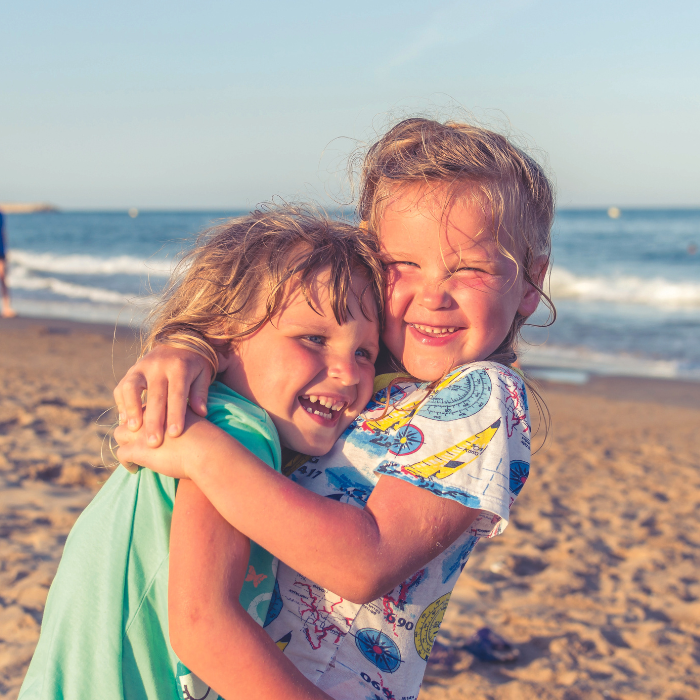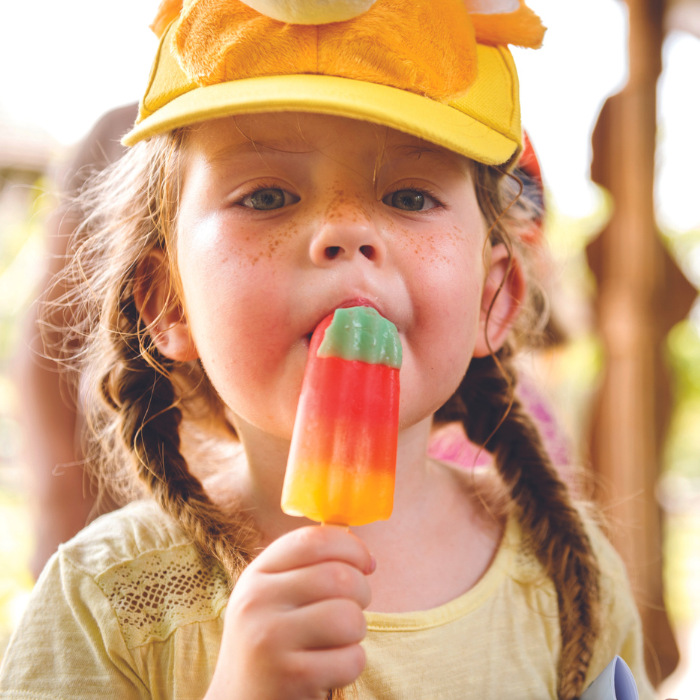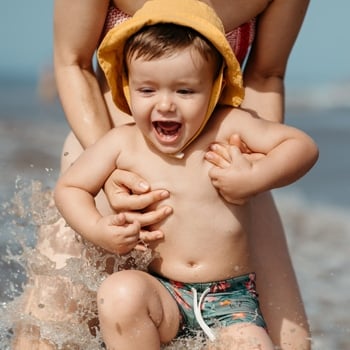
Here is the essential know-how to help keep you and your family safe this summer.
SUNBURN
Signs and symptoms: redness, swelling, tenderness, pain and hot skin.
What to do? Cool the skin – a cool bath will help. Relief can also be achieved with analgesic painkillers, aloe vera lotions and moisturisers. Seek medical advice if there is extensive blistering, chills and fever. Practise sun safety to prevent sunburn (see below).
HEAT STROKE OR SUN STROKE
Signs and symptoms: headache; hot, flushed and dry skin; above normal body temperature; seizures and blurred vision; unconsciousness.
What to do? If heat stroke is suspected, dial 111 for an ambulance. The best way to manage it is to rest in a cool place in a stable side position. Keep them cool by spraying with water or using ice packs.
HEAT RASH
Signs and symptoms: Prickling or stinging sensation, feeling itchy. Inflamed sweat ducts look like small bumps with a red halo, grouped together under your child’s clothing and inside folds of skin.
What to do? Heat rash usually goes away in a few days. Treat with: lighter clothing; moving to a cooler environment; mild strength topical steroids (usually not needed). Apply soothing calamine lotion and compresses with cool water.
Seek medical advice if rash is severe and causing ongoing discomfort.
SEA BATHER’S RASH
This affects the skin under the bathing suit and is caused by stings of the larval forms of certain sea anemones and thimble jellyfishes.
Signs & symptoms: A tingling sensation develops into an itch over several hours and can last for several weeks.
What to do? Remove swimming costume, take a shower. An ice pack may provide relief, as will certain hydrocortisone and calamine lotions. Machine-wash the bathing suit or thoroughly rinse it in alcohol or vinegar, then wash by hand with soap and water.Seek immediate medical advice if the reaction is severe with headache, fever, chills, weakness and vomiting, itchy eyes and burning on urination.
JELLYFISH STINGS
Signs & symptoms: Jellyfish stings can be painful and extensive stinging may lead to nausea, vomiting, headache, chills, drowsiness and breathing difficulties.
What to do? Avoid rubbing the affected area. Flush with sea water to help remove any tentacles. A hot shower is the best treatment. Should I consult a doctor? Yes, if additional pain relief is required.
Call 111 for an ambulance if symptoms are severe.
SPIDER BITES
Signs & symptoms: Pain, redness, swelling, and itchiness and, less commonly, nausea, vomiting, malaise, and headache.
What to do? Identify your spider! The venom of spider bites is variable.
General advice is:
For any suspected spider bite, see a doctor if the bite area becomes very red or painful, blisters, appears infected, or forms an ulcer. If you suspect you have been bitten by a katipo or redback spider, seek urgent medical attention.
WASP/BEE STINGS
What to do? If the reaction is mild, insect stings should be treated by first removing the stinger. Scrape it off using a ruler or piece of paper to limit venom injection. Wash the area well. Reduce swelling and pain with an ice pack. Any stings to the eye, mouth, throat, face, neck or genitalia should be medically assessed.
If the person is allergic, dial 111 for an ambulance.
SUN SAFETY
- Protect yourself and your children from NZ’s very high UV radiation levels.
- There is strong evidence that too much sun exposure during childhood and adolescence is a risk factor for developing skin cancer later in life.
- Cover up and protect from the sun between the hours of 11am and 4pm during the daylight saving months.
Children are more vulnerable to heat and sunstroke. Avoid sunstroke by:
- Offering frequent drinks of water.
- Limiting outdoor activities during the hottest part of the day.
- Keep them out of direct sunlight or crowds when it’s hot outside.
- Make your child rest often in a cool area.
- Dress them in light-coloured, lightweight and loose clothing.
WATER SAFETY
- Provide opportunities for your child to learn to swim.
- Active supervision means being within sight and reach of children without distractions – not reading, talking on the cellphone or sunbathing. Remember, lifeguards are not babysitters.
- When at a beach, don’t overestimate your child’s ability to cope in the open water.
- Always swim between the flags.
BOAT SAFETY
- Life jackets should be worn at all times, and make sure they are the correct size.
- Ensure the water craft you are in is fully equipped for any emergencies,
with a working radio and flares. - Check the weather conditions before you set out.
- Keep your boat an alcohol-free zone.
- Check the marine weather forecast.
- Do not overload the boat.
- For a checklist of what to assess before heading out on the water, download a ‘Boating Safety Guide’ at www.coastguard.co.nz
CAR SAFETY
- All children up to 148cm in height need to be in the correct size car seat or booster seat and the restraint needs to be correctly installed to be effective.
- Never leave children or infants in carseats unattended – the inside of cars can heat up to dangerous temperatures in minutes, even with the windows down.
- Cover the car seat when not in use with a towel or blanket. The metal and plastic parts of seat buckles can become extremely hot, and can result in burns or severe discomfort for young children.
- Taking regular breaks on longer journeys to get some fresh air, move around and cool down. Plan your journey to allow time for regular stops.
OUTDOORS SAFETY
- Plan, prepare and equip yourself properly for any bush walks or tramping.
- Be realistic about the capabilities of your family/group.
- Tell other friends/family of your plans.
- Don’t forget that you can’t light fires when tramping, hunting or walking.
- You can use established barbecues at campgrounds, but otherwise use only camping cookers/burners and stay with them while lit.
FOOD SAFETY
- Wash and dry hands before food preparation.
- Make sure food surfaces and BBQ tools are clean.
- Precook chicken, meat patties and sausages before barbecuing.
- Put marinading meats in covered container in the fridge, not the bench.
- Don’t leave food in a hot car, use a chillybin if your trip home is going to be long.








